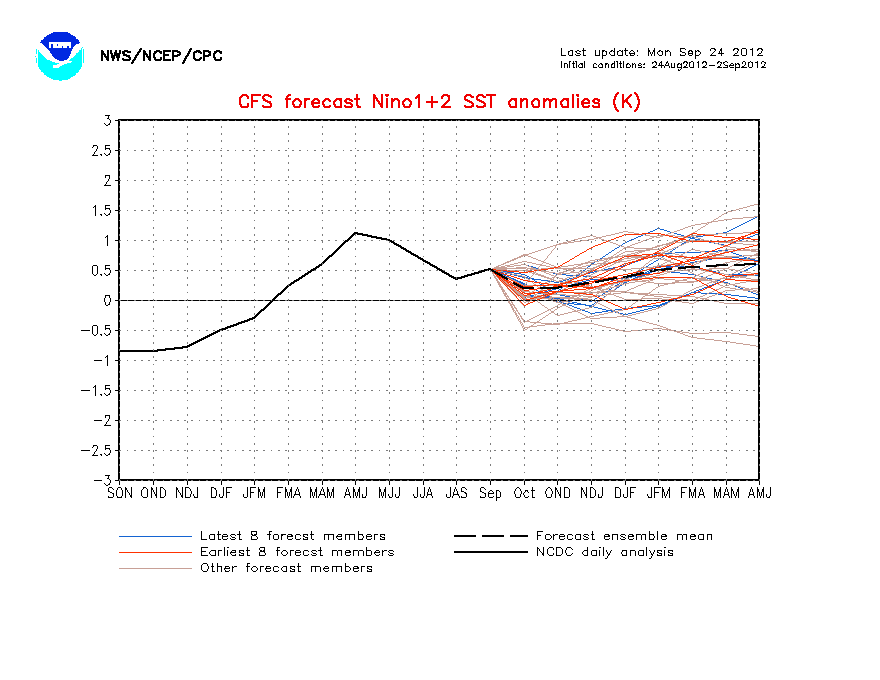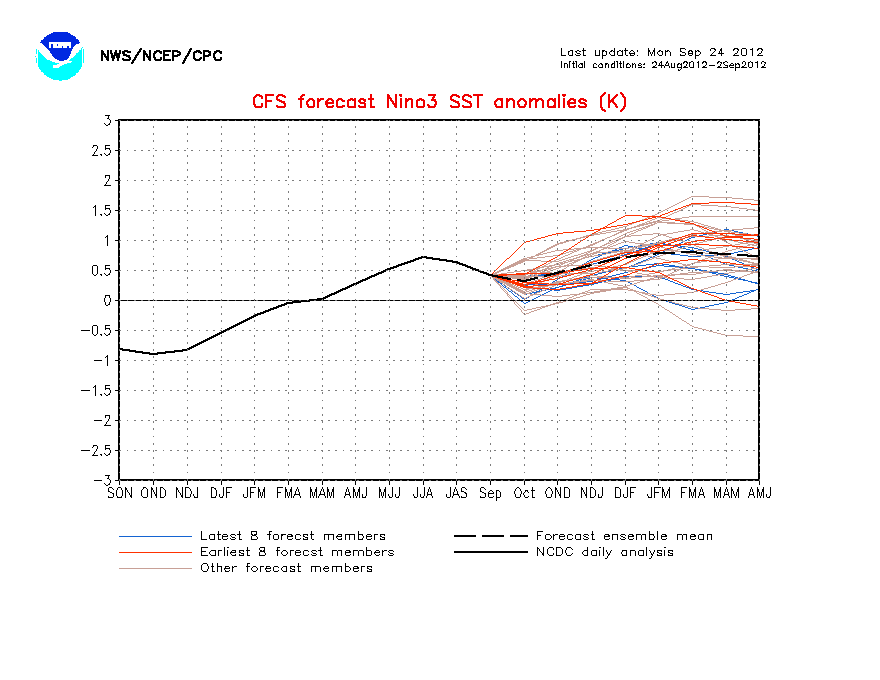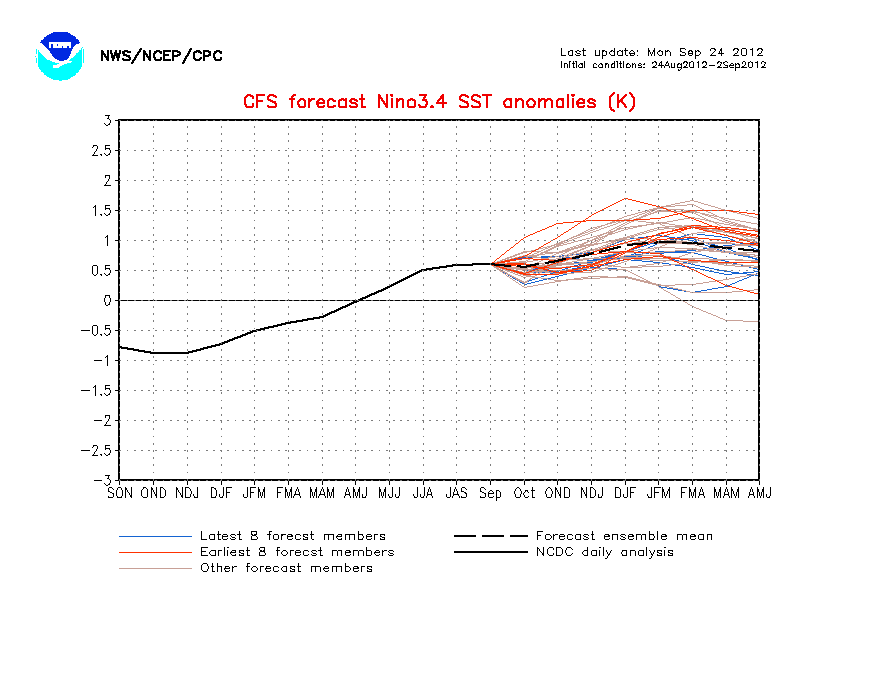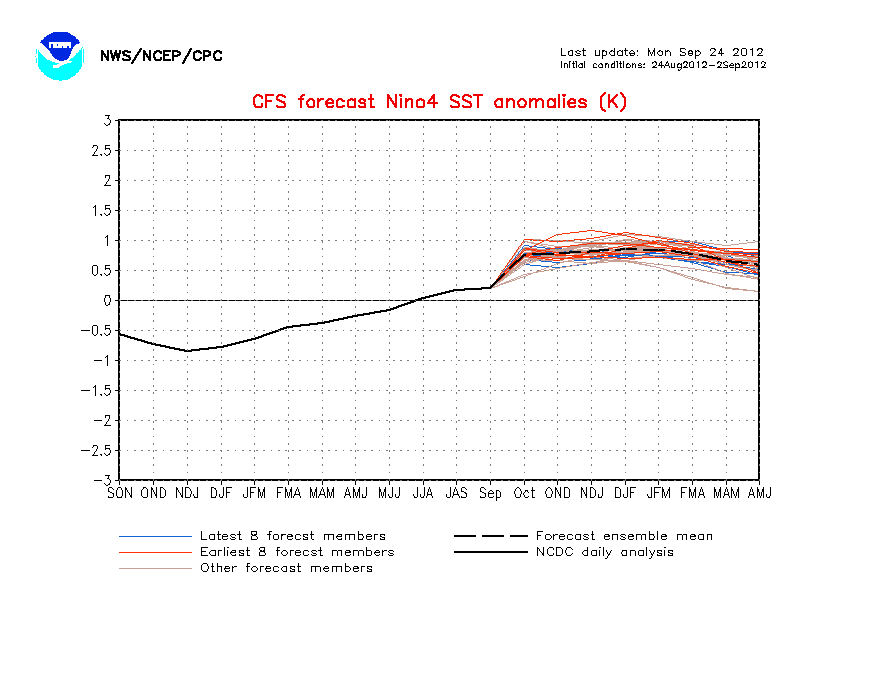This is a forecast discussion about a potential significant severe weather outbreak in the Plains in the next 2 days.
(Note: Significant Severe forecast discussions will be issued rarely.)
FORECAST DISCUSSION
Multiple parameters out of the latest Storm Prediction Center SREF model run indicate a significant severe weather event seems on the table Monday into Tuesday.
Because there are so many images I could post, I will only post one and explain.
CRAVEN/BROOKS SIGNIFICANT SEVERE WEATHER PARAMETER
(Significant severe weather usually occurs when values in this parameter exceed 20,000.)
This image is 24 hours out.
As we can see, the Craven/Brooks image indicates there is a strong potential for significant severe storms (2+ inch hail, 65+ knots, EF2+ tornadoes) in this time frame. Should storms develop, I would be extremely concerned about that specific area in Kansas.
We apologize we cannot get more parameters on here, but tomorrow The Weather Centre will have a full write-up ready.
Keep an eye on this situation should you live in Kansas into the Midwest.
Sunday, March 20, 2011
March 20 Forecast Discussion
This is an image 24 hours out from the 12z GFS.
Low pressure working its way across the eastern Great Lakes will create some showers and storms as it moves through, carrying a punch of warmer air. Convective thunderstorms are possible with this situation.
Warm spell will continue across the Central US including the Plains, Midwest.
Low pressure in the Northwest will keep the warm spell away and also provide for a wet day tomorrow.
Specific concern involves low pressure dropping into Kansas. This low pressure will be the base for a severe weather outbreak that will occur in the Plains to the Midwest in the next 3 days as a squall line, especially into Tuesday. Will definitely have to watch this situation unfold.
Another concern is a potentially unstable atmosphere into Kansas, as we see Mexico heat level air appear in Kansas at that time. The slightest shower may turn into a huge storm.
Nothing in the Southeast to speak of.
This has been a daily forecast discussion. Check back for another one tomorrow at 7:30 pm CDT.
Low pressure working its way across the eastern Great Lakes will create some showers and storms as it moves through, carrying a punch of warmer air. Convective thunderstorms are possible with this situation.
Warm spell will continue across the Central US including the Plains, Midwest.
Low pressure in the Northwest will keep the warm spell away and also provide for a wet day tomorrow.
Specific concern involves low pressure dropping into Kansas. This low pressure will be the base for a severe weather outbreak that will occur in the Plains to the Midwest in the next 3 days as a squall line, especially into Tuesday. Will definitely have to watch this situation unfold.
Another concern is a potentially unstable atmosphere into Kansas, as we see Mexico heat level air appear in Kansas at that time. The slightest shower may turn into a huge storm.
Nothing in the Southeast to speak of.
This has been a daily forecast discussion. Check back for another one tomorrow at 7:30 pm CDT.
March 20 North Illinois Severe Weather Event Update #1
This is an update for the North Illinois Severe Weather event currently occurring.
Below is a real-time animation of the radar, provided by Wunderground.
Specific concerns regarding that image are that the strongest storms appear to be on Lake Michigan at this time, but more storms are firing up in Wisconsin and Central Illinois.
Below is a real-time animation of the radar, provided by Wunderground.
Specific concerns regarding that image are that the strongest storms appear to be on Lake Michigan at this time, but more storms are firing up in Wisconsin and Central Illinois.
Severe Weather Situation #010
This is Severe Weather Situation #010.
As of 6:41pm CDT on March 20, 2011... Strong storms were redeveloping in North Illinois.
Sunshine succeeding the afternoon storms appears to have warmed the previously cold environment to a point that storms had potential to occur.
A trained weather spotter has indicated cloud to ground lightning is occurring in that area.
Radar is also indicating that the storms may be strong in nature.
People in the counties ALONG THE WISCONSIN/ILLINOIS BORDERS are advised to keep an eye to the sky this evening.
Additionally... short range forecast composite reflectivity indicates showers and storms developing in central Illinois moving north while weakening.
Specific Concerns...
CAPE values ~1000 j/kg
Best Lifted Index ~ -4 degrees
Lapse Rates 6.5-8 degrees
Overall atmospheric instability: Moderately Unstable.
As of 6:41pm CDT on March 20, 2011... Strong storms were redeveloping in North Illinois.
Sunshine succeeding the afternoon storms appears to have warmed the previously cold environment to a point that storms had potential to occur.
A trained weather spotter has indicated cloud to ground lightning is occurring in that area.
Radar is also indicating that the storms may be strong in nature.
People in the counties ALONG THE WISCONSIN/ILLINOIS BORDERS are advised to keep an eye to the sky this evening.
Additionally... short range forecast composite reflectivity indicates showers and storms developing in central Illinois moving north while weakening.
Specific Concerns...
CAPE values ~1000 j/kg
Best Lifted Index ~ -4 degrees
Lapse Rates 6.5-8 degrees
Overall atmospheric instability: Moderately Unstable.
March 20 La Nina Update and Forecast
This is an update and forecast on the La Nina currently occurring.
This image shows how we are currently in a fairly neutral stage at this time. However, temperatures in this portion of the forecast are projected to drop, then turn towards an El Nino stage.
The next series of images are from a different forecast area in the ocean but still on the basis of ocean temperatures.
Overall, in these forecast areas, it does appear we are heading for either a neutral state of oceanic temperatures or an El Nino. Tthe latest ensemble members appear to be leaning towards an El Nino, which is especially intriguing since the earliest members prefer a more La Nina term.
We will continue to watch this, but as of now, the official Weather Centre forecast is to head into an EL NINO.
This image shows how we are currently in a fairly neutral stage at this time. However, temperatures in this portion of the forecast are projected to drop, then turn towards an El Nino stage.
The next series of images are from a different forecast area in the ocean but still on the basis of ocean temperatures.
Overall, in these forecast areas, it does appear we are heading for either a neutral state of oceanic temperatures or an El Nino. Tthe latest ensemble members appear to be leaning towards an El Nino, which is especially intriguing since the earliest members prefer a more La Nina term.
We will continue to watch this, but as of now, the official Weather Centre forecast is to head into an EL NINO.
March 20 Large Severe Weather Potential Forecast Discussion
This is a forecast discussion concerning a potentially large severe weather event Monday into Tuesday.
FORECAST DISCUSSION
The Storm Prediction Center has issued some startling outlooks for the Monday-Tuesday time frame.
Below are the two images.
The first image is the risk of severe weather on this time frame.
Immediately, we know that, should this develop, it would be a squall line. That would be a very sure thing.
The second image is an image of probabilities of severe weather.
Keep in mind- When there is a 30% risk of severe weather this far out in forecasting severe storms, that 30% area can turn into a MODERATE RISK for severe thunderstorms.
It also appears this will be a 4 day severe weather event: Today, Monday, Tuesday, and Wednesday.
Areas affected Today: Plains into the Midwest.
Areas affected Monday: Plains into the Midwest and a bit in the Ohio Valley.
Areas affected Tuesday: Plains into the south back through much of the Midwest (images above).
Areas affected Wednesday: Ohio Valley.
This has been a forecast discussion. More will be issued on this topic should they be needed.
FORECAST DISCUSSION
The Storm Prediction Center has issued some startling outlooks for the Monday-Tuesday time frame.
Below are the two images.
The first image is the risk of severe weather on this time frame.
Immediately, we know that, should this develop, it would be a squall line. That would be a very sure thing.
The second image is an image of probabilities of severe weather.
Keep in mind- When there is a 30% risk of severe weather this far out in forecasting severe storms, that 30% area can turn into a MODERATE RISK for severe thunderstorms.
It also appears this will be a 4 day severe weather event: Today, Monday, Tuesday, and Wednesday.
Areas affected Today: Plains into the Midwest.
Areas affected Monday: Plains into the Midwest and a bit in the Ohio Valley.
Areas affected Tuesday: Plains into the south back through much of the Midwest (images above).
Areas affected Wednesday: Ohio Valley.
This has been a forecast discussion. More will be issued on this topic should they be needed.
March 20 Severe Weather Event Forecast Discussion
This is a forecast discussion concerning a potential for severe weather going into today.
FORECAST DISCUSSION
The RUC model, a very short range model, is indicating the potential for a severe weather event today.
The Best Lifted Index, featured below, is an indicator of instability in the atmosphere. Image from 12z RUC 12 hours out.
The way BLI (Best Lifted Index) is classified is the following:
Values above 0: Very to marginally stable.
Values 0 to -2: Somewhat unstable, storms unlikely.
Values -2 to -6: Unstable, Storms likely, some severe with lift in the atmosphere.
Values below -6: Extremely unstable, severe storms with lift.
Looking at the image above, some hints I can point out are a potential squall line along the instability line. Another hint is that the strongest storms could exist in the northern areas of this squall line, where there is more BLI.
This squall line, should it develop, would move VERY slowly according to the RUC. That would not be good for people in flooding zones. However, it reduces the chances of tornadoes due to how slow it may be going. At the same time, the squall line is expected to be weakening.
Next up, we have the same RUC run's depiction of Lapse Rates. The time frame is the same time frame as with the image above.
Lapse Rates are indicators of instability. They show the temperature change with height.
Values less than 5.5 to 6 degrees are considered very stable, while values near 9.5 degrees are considered absolutely unstable.
Taking that information and plugging it in to the forecast shows values of 7.5-8 degrees abundant across the right board, with values reaching 6.5-7.5 degrees on the left image.
Based on that, we can make a prediction that at least moderate instability will exist throughout the predicted area of the squall line.
So this is a potential severe weather situation. Keep in mind these are only predictions. It may develop, it may not. The Weather Centre is only just beginning to shift into severe weather phase.
FORECAST DISCUSSION
The RUC model, a very short range model, is indicating the potential for a severe weather event today.
The Best Lifted Index, featured below, is an indicator of instability in the atmosphere. Image from 12z RUC 12 hours out.
The way BLI (Best Lifted Index) is classified is the following:
Values above 0: Very to marginally stable.
Values 0 to -2: Somewhat unstable, storms unlikely.
Values -2 to -6: Unstable, Storms likely, some severe with lift in the atmosphere.
Values below -6: Extremely unstable, severe storms with lift.
Looking at the image above, some hints I can point out are a potential squall line along the instability line. Another hint is that the strongest storms could exist in the northern areas of this squall line, where there is more BLI.
This squall line, should it develop, would move VERY slowly according to the RUC. That would not be good for people in flooding zones. However, it reduces the chances of tornadoes due to how slow it may be going. At the same time, the squall line is expected to be weakening.
Next up, we have the same RUC run's depiction of Lapse Rates. The time frame is the same time frame as with the image above.
Lapse Rates are indicators of instability. They show the temperature change with height.
Values less than 5.5 to 6 degrees are considered very stable, while values near 9.5 degrees are considered absolutely unstable.
Taking that information and plugging it in to the forecast shows values of 7.5-8 degrees abundant across the right board, with values reaching 6.5-7.5 degrees on the left image.
Based on that, we can make a prediction that at least moderate instability will exist throughout the predicted area of the squall line.
So this is a potential severe weather situation. Keep in mind these are only predictions. It may develop, it may not. The Weather Centre is only just beginning to shift into severe weather phase.
Subscribe to:
Comments (Atom)











